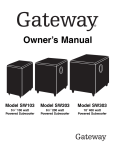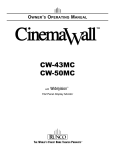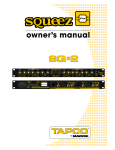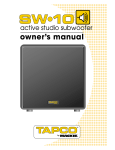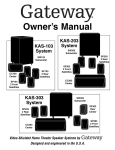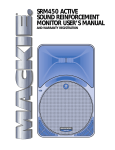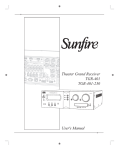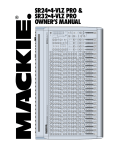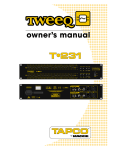Download Untitled - Karma Digital
Transcript
Important Safety Instructions 1. Read Instructions 2. Keep these Instructions 3. Heed all Warnings. 4. Follow all Instructions 5. Do not use this apparatus near water. 6. Clean only with dry cloth. 7. Do not install near any heat sources such as radiators, heat registers, stoves, or other apparatus (including amplifiers) that produce heat. 8. Unplug this apparatus during lightning storms or when unused for long periods of time. 9. Refer all servicing to qualified service personnel. Servicing is required when the apparatus has been damaged in any way, such as a power-supply cord or plug is damaged, liquid has been spilled or objects have fallen into the apparatus, the apparatus has been exposed to rain or moisture, does not operate normally, or has been dropped. 10. Ventilation — The apparatus should be situated so that its location or position does not interfere with its proper ventilation. For example, the apparatus should not be situated on a bed, sofa, rug, or similar surface that may block any ventilation openings; or placed in a built-in installation such as a bookcase, cabinet, or closed equipment rack that may impede the flow of air through ventilation openings. 11. Power Sources — The apparatus should be connected to a power supply only of the type described in these operation instructions or as marked on the apparatus. 12. Power Cord Protection — Power-supply cords should be routed so that they are not likely to be walked upon or pinched by items placed upon or against them, paying particular attention to cords at plugs, convenience receptacles, and the point where they exit the apparatus. 13. Non-use Periods—The power cord of the apparatus should be unplugged from the outlet when unused for a long period of time. 14. Object and Liquid Entry — Care should be taken so that objects do not fall into and liquids are not spilled into the inside of the apparatus. 15. Servicing — The user should not attempt to service the apparatus beyond those means described in this operating manual. All other servicing should be referred to qualified service personnel. 16. To Prevent Electric Shock, do not use this polarized plug with an extension cord, receptacle or other outlet unless the blades can be fully inserted to prevent blade exposure. Pour préevenir les chocs électriques ne pas utiliser cette fiche polariseé avec un prolongateur, un prise de courant ou une autre sortie de courant, sauf si les lames peuvent être insérées à fond sans laisser aucune pariie à découvert. 17. Grounding or Polarization — Precautions should be taken so that the grounding or polarization means of the Component is not defeated. This apparatus does not exceed the Class A/Class B (whichever is applicable) limits for radio noise emissions from digital apparatus as set out in the radio interference regulations of the Canadian Department of Communications. ATTENTION — Le présent appareil numérique n'émet pas de bruits radioélectriques dépassant las limites applicables aux appareils numériques de class A/de class B (selon le cas) prescrites dans le règlement sur le brouillage radioélectrique édicté par les ministere des communications du Canada. User's Manual WARNING:THIS SUBWOOFER IS CAPABLE OF PRODUCING VERY HIGH SOUND PRESSURE LEVELS. YOU MUST TAKE EVERY PRECAUTION TO PROTECT YOUR HEARING FROM PERMANENT DAMAGE. Contents afety Instructions.......................................... 2 S Introduction.................................................... 4 Features......................................................... 4 Unpacking and Care...................................... 4 Overview........................................................ 5 Amplifier Features.......................................... 6 Amplifier Installation....................................... 9 Connections................................................. 10 Subwoofer Installation.................................. 11 Room Equalization Procedure..................... 12 System Configurations................................. 14 Adjusting the Controls.................................. 17 Specifications............................................... 18 Subwoofer Installation Instructions.............. 19 Troubleshooting Guide................................. 21 Limited Warranty.......................................... 23 Service Assistance....................................... 23 For more information on this and other Sunfire products, please visit our website: www.sunfire.com User's Manual Introduction Thank you for purchasing this Sunfire SubRosa™ Subwoofer. We hope you enjoy it and the music it makes as much as we have enjoyed creating it for you. The big breakthrough features of the subwoofer are its uncanny tracking downconverter, its long throw, high back-electromotive force drivers, and its fullyautomatic room equalizer. Taken together, they provide this subwoofer with as much bass as you could get from several 15 inch drivers mounted in a cabinet the size of a small refrigerator. Unpacking Your Sunfire subwoofer should reach you in perfect condition. If you do notice any shipping damage, please contact your Sunfire Dealer immediately. It requires two people to gently lift out the unit and remove all the packing material. It is important to save all the packing materials and the box in case your subwoofer ever needs to be moved or shipped for repair. Make sure that you keep your sales receipt. It is the only way to establish the duration of your Limited Warranty and it may come in useful for insurance purposes. Please take a moment to fill out and mail the Sunfire Customer Response card. Also read the serial number located on the control panel and record it here: Serial Number: Purchased from: Date: Features Amplifier • 2,700 watt, high-efficiency amplifier • Automatic room equalization mode • Measurement microphone included • Very low distortion • Automatic signal-sensing turn-on and standby mode • 12 VDC trigger input for remote turn-on • Balanced XLR input • Line-level unbalanced inputs • Speaker-level binding post inputs • Line level high-pass outputs • Continuously variable phase control • Continuously variable crossover frequency adjustment, 35 to 100 Hz • Continuously variable volume level • Soft clipping circuit allows graceful overload and prevents speaker damage due to clipping • Gold-plated inputs and outputs Subwoofer • Stunning output from a slim design! • Hand-polished, high gloss, ebonized rosewood finish • Low-profile design for wide variety of applications • Custom designed woofers use neodymium magnets for high-strength in a compact package • StillBass™ anti-shake technology for improved performance Care To maintain the speaker cabinet’s finish, first unplug the power cord and then use a soft cloth to clean the surfaces. If your Sunfire subwoofer needs servicing, please read the Troubleshooting section on page 21. If a problem persists, please contact your nearest authorized Sunfire Dealer. User's Manual Overview Your Sunfire SubRosa subwoofer is designed to give you the best possible low-frequency sound quality for your Home Theater experience. It incorporates a tremendously powerful amplifier and a pair of drivers to produce tight, floor-rumbling, denture-rattling bass that you can feel as well as hear. The subwoofer has an automatic equalization system that will tailor the subwoofer output to compensate for any room effects. It also has a manual equalization mode. The subwoofer has an adjustable high cut filter and line-level inputs for easy incorporation into existing systems, or as part of a subwoofer/satellite speaker combination. Controls for adjusting the volume, crossover frequency and phase, allow the subwoofer to be perfectly matched to any listening environment and audio components. The Drivers To have lots of bass requires moving lots of air. Your Sunfire subwoofer incorporates two drivers that can move back and forth approximately five times more than a normal subwoofer. This gives it a lot of air moving capacity which allows for majestic bass performance. The woofers are high-strength designs, using neodymium magnets. User's Manual The Amplifier The large movement range of the drivers creates greater air pressure inside the box than a conventional subwoofer. Therefore, the drive amplifier must be much more powerful than an ordinary subwoofer amplifier. In fact, it has to be so powerful, it is almost hard to believe. The power amplifier within your Sunfire subwoofer is capable of delivering over 2,700 watts. When the same full output is applied to the drivers, however, the enormous back-electromotive force generated as a consequence of its large motion and giant magnets, causes the current flow to be much less. It is this singular property of the drivers that allows the subwoofer to be approximately ten times more efficient than a subwoofer this size would normally be. A compressor circuit kicks in automatically if the input signal level reaches a level that would overload the drivers. This maintains a ceiling on the output without clipping. If the input signal is driven even further, a ‘soft clipping’ circuit is enabled. This allows the subwoofer to put more sound into the room to satiate the power hungry user, but without distortion or damage to the subwoofer. Thus, for explosive scenes in movies, this produces extremely high sound pressure levels (SPL) in your room without the drivers banging against the mechanical stops. For more details of the subwoofer design, please call us or visit our website: www.sunfire.com. Amplifier Features 12 3 4 5 1. Standby LED and 2. Power Switch Press the power switch in to turn on the amplifier. As a general rule, turn it on after your preamplifier or receiver is turned on. When you have finished listening for the night, turn it off before your preamplifier or receiver. After a period of inactivity (i.e. with no input signal), the amplifier will automatically turn itself to Standby mode, where it is effectively off. It can however, turn back on automatically when an audio input signal is present, if a 12 VDC trigger voltage is applied to the Trigger inputs, or if the Start button is pressed. 3. Start button Press this once to enter the Auto EQ mode (if the sub is out of Standby mode). Press and hold it down for several seconds to enter the Manual EQ mode. See page 12 for more details on this and the EQ controls. 4. LED display These LEDs are used during the Auto EQ and Manual EQ procedures. 5. Microphone Input This is where you plug in the supplied linear measurement microphone when you want to use the Auto EQ mode. (Only use the supplied microphone.) 6 7 8 9 10 6. Equalizer Authority This control's primary purpose is to adjust the EQ Authority. During normal listening, you can adjust the overall EQ from none (ccw, 0%), to fully equalized (cw, 100%). For example, if your first band has a 6 dB boost, setting this control to 50% would make it boost only 3 dB. This control is also used during the Manual EQ mode to adjust each of the four internal EQ bands, and allow you to add "color" to the sound as desired. 7. Phase Control This control changes the relative phase of the subwoofer with respect to your other speakers. Use this control to help blend the subwoofer with the rest of your system. This is accomplished by adjusting the control in small increments as you listen for the most bass at your listening position. As a final trim, readjust the Crossover Frequency and Volume controls after the Phase has been set. 8. Crossover Frequency This controls the high frequency cutoff point. With the control at the 100 Hz mark, the subwoofer will reproduce frequencies up to 100 Hz. If the control is set fully clockwise, the crossover is bypassed and the subwoofer will reproduce a frequency range up to 115 Hz. With the control fully counterclockwise the subwoofer reproduces a narrow range, up to 30 Hz. User's Manual 11 12 13 14 Rotate the crossover frequency control until the bass sounds natural. If the mid-bass sounds good but you want more low bass, turn this control down a little, then turn the Volume control up by about the same amount. This increases the low-bass output while leaving the mid-bass output the same. 9. Volume This control lets you match the output level of the subwoofer to the level of your satellite/main speakers. The subwoofer output will increase as this control is rotated clockwise. When you have just installed your system, turn this down first before turning on your subwoofer. This will prevent any loud surprises. 10.Rack Ears The subwoofer amplifier comes with two rack ears which allow it to be mounted in a standard 19 inch rack. Allow one rack space for the amplifier, and one rack space minimum above and below it for ventilation. The rack ears are easily fitted and removed using four existing screws as shown. side screws bottom screws User's Manual 15 16 17 11.Line-Level Inputs Connect these unbalanced inputs with RCA type patch cords to the line-level outputs of your receiver or preamp. If your preamplifier or receiver has a single sub/LFE output, connect it to the sub amplifier’s left input jack (see page 14). There is then no need to use the right input jack. If you want to run your main/satellite speakers full range, use a “Y” adapter at the preamplifier outputs (see page 15). In this way, you can send the preamplifier’s output signal to your main amplifier and to the sub amplifier at the same time. 12.Outputs Line-level high-pass output signals are available at these jacks. These outputs are active whenever a signal is hooked up to the line-level inputs of the sub amplifier. This crossover is a passive network with a fixed crossover frequency of 70 Hz and a 6 dB per octave slope. We recommend using this high-pass function with main/satellite speakers that are small and not designed to reproduce low frequencies. If your main speakers are capable of operating full range, then you will not need to use the high-pass function. To use the high-pass outputs, connect the preamp outs on your preamp/receiver to the sub amplifier’s line level inputs using good quality RCA type Control Panel Features continued 11 12 13 14 patch cords. Then connect a second patch cord from these outputs to the inputs of your main amplifier. This will allow your main speakers to operate at frequencies above 70 Hz and the subwoofer to operate at frequencies below 70 Hz (see page 16). 13.Balanced (XLR) Input Use this balanced input to connect to the balanced line-level output of a Home Theater preamplifier or other source. Balanced connections offer superior noise cancellation over unbalanced connections, so if your preamp has an XLR sub output, we recommend that you use it. 14.Trigger Inputs These two inputs can be used to automatically turn on the sub amplifier. To do this, connect 12 VDC to either of these terminals. Some Home Theater preamplifiers, such as the Sunfire Theater Grand series, have matching 12 VDC Trigger outputs. When they are turned on, the subwoofer will turn on. 15.Speaker Level Outputs This is the connection to the subwoofer. Use high-quality speaker wire. The red post is the positive output, and connects to the positive (red) post of your subwoofer. The black post is the negative, and connects to the negative (black) post of your subwoofer. The posts can accept bare wire, spade terminals, and dual or single banana connectors. 15 16 17 The amplifier is designed to power only the Sunfire SubRosa subwoofer. No other subwoofer or speaker should be connected, or this may lead to serious damage to your equipment. 16.Line Fuse The subwoofer is supplied with a conservative slow-blow type fuse to protect the electronics. Always unplug the power cord before inspecting or changing the fuse. Never use a fuse with a larger current rating than shown on the markings next to the fuseholder. Use a small flat screwdriver to pry out the fuseholder and replace the fuse. 17. IEC Linecord socket The sub amplifier comes with a detachable linecord that connects here. US (120 VAC) MODEL: Connect the linecord to the subwoofer before connecting the other end to an 120 Volt, 60 Hz AC outlet. The outlet must have a circuit rating of 8 amps or more (a typical home circuit is rated at 15 amps). Never plug the US (120 VAC) Model subwoofer directly into 220-240 Volts AC as this will cause catastrophic circuit failure. User's Manual Amplifier Installation Observe the following general precautions and read the safety instructions on pages 2 and 3 before using your Sunfire subwoofer. • The amplifier may be rack mounted using the supplied rack ears. It will fit into a standard 1U, 19 inch rack space. Allow a minimum of 1 free rack space above and below for ventilation. • The amplifier may also be placed on a shelf, supported on its feet. Make sure it is not placed on carpeting or similar that may obscure its ventilation openings. • Never open the amplifier cabinet as this might result in an electrical shock to you, or damage to the unit. • Protect the amplifier and subwoofer from prolonged exposure to direct sunlight and other direct sources of heat, such as heating vents and radiators. • To prevent fire or shock, do not expose the amplifier or subwoofer to rain or moisture. If fluid or a foreign object should enter either unit, immediately turn off the power and contact your Sunfire Dealer. • Avoid excessive exposure to extreme cold or dust. • Do not place heavy objects on top of the amplifier or subwoofer. AC Power Considerations Ensure that the amplifier is plugged into an outlet capable of supplying the correct voltage specified for your model. Unplug your amplifier’s power cord from the electrical outlet if it will be left unused for a long period of time. Route the power-supply cord so it is not likely to be walked on or pinched by items placed upon or against it, especially at plugs, convenience receptacles, and the point where it exits from the unit. Heat rise • Allow adequate ventilation around the top and sides of the amplifier. • Allow adequate ventilation if you are rack-mounting the amplifier. User's Manual Connections Please consider the following when setting up your new system : • Before making or changing any connections, ALWAYS make sure that the sub amplifier and your other components are turned OFF. Also turn down the volume control of the sub amplifier and your preamplifier or receiver. • Whenever possible, keep the power cords away from the signal cables or speaker wires to prevent any hum or interference being heard in the speakers. • Choose reliable, high quality interconnect cables, also called patch cords or RCA cables. They should be fully shielded and as short as possible for the job. The longest cable in your system will likely be to the subwoofer, so choose a good quality brand. • Some patch cords can be a very tight fit and there is usually a preferred method of getting them off. Some have to be removed with a twisting action. Be gentle or you may damage the jacks of the subwoofer amplifier or your other components. Tap e Deck DVD Preamplifier Power strip Amplifier Speaker Level connections • The subwoofer’s speaker level inputs can accept speaker wires with banana, dual-banana, bare wire or spade terminals. If you have banana type connectors on your speaker wire, make sure that you tighten the binding posts before inserting. Make sure that the negative speaker wires never touch the positive wires as this will short out and possibly damage your amplifier. AC outlets on the same circuit breaker Sub Amplifier 10 • This diagram shows all the low power components sharing a power strip which is connected to the same outlet used by your main amplifier. • The subwoofer amplifier is connected to an outlet on the same circuit breaker, provided that the total system current draw does not exceed the breaker current rating. • This arrangement will reduce the possibility of an audible hum in your system caused by a ground loop. User's Manual Subwoofer installation Mounting options Your subwoofer has three mounting possibilities. (You will need an assistant to help lift and position the subwoofer.) A. Free standing. Two brackets are easily fitted to the subwoofer with thumbscrews. B. Vertically. The subwoofer can be fitted up against a wall, with one foot bracket on the floor. The subwoofer must be held to the wall using special fittings supplied, and it must have one of the foot brackets fitted to the lower edge. Never leave the subwoofer standing vertically without it being secured to the wall. C. Flat. The subwoofer can be fitted with four supplied feet, and placed on its back. It can even fit under couches. See page 18 for more details of the different mounting options. Finding a good location Although low frequencies are non-directional, factors such as room reflections, standing waves, resonance and absorption will strongly affect your subwoofer’s performance. Moving the subwoofer from one location to another can have a major effect on the bass response. The Auto EQ mode will let you adjust for the room effects, but you should find the best location first. User's Manual The following procedure will help you find the best location for your subwoofer. (This method may seem a bit odd, but it is based on solid principles of acoustic physics.) 1. Start by placing the subwoofer right on the seat of your favorite couch or easy chair, with the woofers facing upwards. Position it with care so it is not likely to fall off. If this is not practical, then move the couch and place the subwoofer either face up with four feet attached (mounting option C), or horizontally with two brackets attached (option A). 2. Connect the SubRosa amplifier and the subwoofer with speaker wire, and connect a power cord to the amplifier. 2. If you are using the subwoofer as part of a Home Theater system, you can either run a calibration test (noise) signal through the subwoofer, or simply plug the analog outputs of a CD player directly into the sub amp’s line-level inputs. Turn down the sub amp's volume level before turning on the CD, then play some of your favorite music samples with heavy bass. 3. Walk around the room, listening, and stand in all the positions where you might be able to place the subwoofer. Try crouching down, and try the corners. Find the most practical place where the subwoofer's bass output sounds best. 4. Shut things down and install the subwoofer in this position. Magnetic Fields We recommend that you place your subwoofer further than two feet away from your TV, VCR, tape deck or computer, so the speaker’s magnet won’t distort the colors of your TV picture or erase your video tapes, audio tapes or computer discs. 11 Room Equalization Procedure Subwoofer performance is greatly affected by the room in which it is situated, and the positioning within the room. The room effects will boost and cut the output levels reaching your listening position. This gives a "room EQ" effect which can often be far from wonderful. The SubRosa EQ system can automatically adjust for the effects of room EQ. It measures the actual frequency response using the supplied measurement microphone. Then it automatically compensates for peaks or dips and smooths out the response. Have the kids play in the backyard and give the dog a treat to stop him barking. A small amount of noise, such as quiet talking or whispering, is OK. 3. Place the microphone in the listening position (on the couch, for example), pointing in the direction you’ll normally be facing while listening to your system. Only use the microphone supplied. 4. Plug the microphone into the subwoofer amplifier's microphone jack. 5. Set these controls: • Volume to 0 dB. • Crossover to "Bypass." • Phase to "Normal." • Equalizer Authority to "Normal" For best results it is recommended that the subwoofer crossover in your receiver or processor be set to its maximum setting (or “bypass”). This ensures that the 6. Turn on the amplifier's power switch subwoofer will be properly matched to the and press the Start button to go from rest of the speakers in your system. standby to play mode. Press Start again to start the calibration. The following procedure will help you start the automatic equalization: 7. The subwoofer will generate a test tone sweep, slowly increasing up the freAutomatic EQ Mode quency scale; the microphone will take measurements of the sound arriving at 1. Install the subwoofer in the best location your listening position. The LEDs will you can find, using the procedure on the flash randomly for a while, then the pairs previous page. will gradually glow constantly as each 2. The calibration must be done while the band is measured (from left to right). listening room is quiet. Please turn off This sequence will repeat twice until the any noisy machinery, including heating measurements are complete. The LEDs or cooling systems during this process. will all blink once and stay on, and the test tones will stop. 12 User's Manual If you find that the first test tone plays louder and louder, and never leaves the first band, then either the microphone is too far away from the subwoofer, or it is not plugged in correctly. 8. The procedure may take several minutes. Do not make any loud noise during this process, as it may affect the accuracy and/or make it take longer. 9. The sub automatically calculates the best equalization, based on the measured frequency response at your listening position. This will be saved, before returning to the normal listening mode. 10. In normal listening, you can adjust the overall effect of the saved EQ settings with the Equalizer Authority control. Normally you would turn it to 100% for full equalization. You can turn it to 0% to judge the effect of no equalization, or vary it to suit your taste. 11. Repeat the Auto EQ procedure if you change the location of the subwoofer, or if you rearrange your furniture. Manual EQ Mode this manual procedure if you think the equalization might still need a tweak: 1. Set these controls: • Volume to 0 dB. • Crossover to "Bypass." • Phase to "Normal." • Equalizer Authority to "50%" 2. Turn on the sub amp's power switch. 3. Press and hold down the Start button for several seconds, until the first pair of LEDs light up. 4. A low frequency test tone will sound to help you adjust the lowest band. 5. Adjust the volume by turning the Equalizer Authority control (or press Start to skip and move on to the next band). You will have to sit back in your listening position each time to listen for the effect, or seek the help of a loved one or kind friend to turn the control while you listen. 6. Press the Start button to move on to the next band, and then adjust the Equalizer Authority control as needed. When you reach the last band, the next press will bring up the first band again. This mode allows you to manually 7. When all bands have been equalized to adjust the room equalization to suit your your satisfaction, press and hold down taste. Some rooms may sound flat or lifethe Start button for several seconds until less without a touch of color to the sound. all the LEDs come on, and the test tone turns off. The Equalizer Authority setThe subwoofer has four EQ bands, tings will be saved for each band, and each represented by two LEDs. Each the subwoofer will return to its normal band is fixed in frequency and bandwidth, listening mode. but each can be adjusted in volume level using the Equalizer Authority control dur8. Use the Equalizer Authority to adjust the ing the Manual equalization mode. effects level of your equalization. This is similar to having sliders on a 4-band graphic equalResetting the EQ izer, except the settings for • Turn off the subwoofer using the each band are stored digitally. amplifier's power switch. The subwoofer saves the setting of the • Hold down the Start button and turn on Equalizer Authority control for each band, the power switch. so adjusting it for one band does not alter • Keep the Start button held down for 10 the adjustment for the other bands. seconds while the LEDs flash. First, you should follow the Automatic • When the LEDs go out, the EQ is reset EQ procedure, so the subwoofer will to the flat factory setting. adjust for the room effects. Then follow User's Manual 13 System Configurations The following pages show some typical connections that you might make in your installation. They show how the inputs and outputs of the subwoofer's amplifier are con nected to your preamplifier or receiver. Connections to a preamplifier’s subwoofer output If your preamplifier has a subwoofer output (often labeled LFE for Low Frequency Effects), it can be connected to the amplifier’s Left (Mono) input as shown. This is the simplest and recommended connection. A receiver with a sub/LFE output can be connected in the same way. The subwoofer will play the low frequency range and the other speakers will play the frequency range delivered to them by your main amplifier. If you have a Home Theater preamplifier, it may have an independent subwoofer volume control. Make sure this is correctly adjusted, and that the Sunfire subwoofer’s crossover frequency is set to 100 Hz. This is by no means an iron-clad rule, rather it is a good starting point. (See the crossover frequency control details on page 6 and adjustments on page 17). You can set the sub amplifier's Volume control to 0 dB, and then use the preamplifier’s subwoofer level control for normal and routine adjustments. 14 User's Manual Connections to a preamplifier using Y cables If your preamplifier does not have a sub/LFE output, you can use “Y” cables to send its main outputs to both the subwoofer amplifier and your main amplifier. The subwoofer will play the low frequency range and your front speakers will play the full range. Although bass is commonly distributed evenly between left and right channels (L+R bass), movie soundtracks often contain differential (L-R) bass. The opening scene in “Top Gun”, for example, has loads of L-R bass information. If this is not preserved, the bass in these scenes sounds anemic. The Sunfire subwoofer utilizes differential gain on the left and right inputs to retain both the L+R and L-R information. Therefore, systems which do not have a dedicated sub/LFE output should use both the left and the right inputs as shown, for the greatest bass impact. An alternative connection method without using Y cables is shown on the next page. If your preamp/receiver has a dedicated sub/LFE output, then only the Left (Mono) input is used, as shown on the previous page. User's Manual 15 Using the line level high-pass outputs If you are using a preamplifier which does not have a sub/LFE output, you can send its left and right front output into the line-level inputs and then connect the sub amplifier’s high-pass outputs to the inputs of your main amplifier. The subwoofer will play the low frequencies and your main amplifier and front speakers will play the frequency range above the subwoofer’s fixed high-pass crossover point. The signals coming out of the high-pass outputs are not affected by any of the controls. They are just a copy of the signals going in except that the low bass is filtered out. This uses the sub amplifier’s passive crossover network, rather than the active network and controls. This is an excellent method if your speakers are small satellites or mini-monitors, and/or your power amplifier is of limited power, such as a tube amp. 16 User's Manual Adjusting the controls There are two main methods for adjusting the level, crossover frequency and phase of the Sunfire subwoofer to match a system: • Sunfire’s preferred method: By listening and making the adjustments to suit your taste. • Laboratory method: By measuring the output and adjusting for a flat frequency response. Excellent results can be obtained if you make the adjustments based on simply listening. This is Sunfire’s preferred method as it allows the system to be voiced based on what sounds the best, whereas laboratory-flat frequency response can often be clinical and less than exciting. Step 4. Use the phase control to make the response even smoother. It has its biggest effect at the crossover frequency. You can iterate between the crossover and the phase controls. Keep your hands off the level control! It was set correctly in step 2. Step 5. Listen to the subwoofer. Resist all temptations to turn up the level control. Play something with really deep bass to confirm that your subwoofer is working.” The following procedure is for those who prefer a more methodical and scientific approach. This excerpt is from “The Audio Critic,” issue 24, page 31, written by contributing editor David Rich, and is reprinted here with their kind permission. You will need a test CD with low-frequency warble tones, and a sound pressure-level meter. The Radio Shack® SPL meter will do fine, as will the Stereophile® test CD. “Step 1. Disconnect the subwoofer and run the main speaker with a tone in its passband (80-100Hz). Measure the level. Step 2. Disconnect the main speaker and reconnect the subwoofer. Set the subwoofer to its highest crossover frequency. Set the level control of the subwoofer to give the same sound pressure level with the same tone you used in Step 1. Step 3. With both the subwoofer and the main speaker connected, measure the level of the tones at the available frequencies. Because the crossover is set too high, you will have a peaked response. Adjust the crossover control to get the smoothest response. User's Manual 17 Subwoofer Installation Instructions Mounting points The rear panel has six threaded holes that allow for three different mounting methods. Horizontal position 1 2 3 In this position, the subwoofer's longest side is horizontal. Two brackets are supplied for this mounting option. With the help of an assistant, gently turn the subwoofer on its side, and secure the brackets to holes 2 and 5 with the supplied thumbscrews. 4 5 6 Always use the brackets when the subwoofer is in this position, otherwise the subwoofer may tip over. Flat on its back In this postion, the subwoofer is flat on its back with the woofers pointing up. Four cylindrical feet and screws are supplied for this purpose. With the help of an assistant, gently turn the subwoofer over, and secure the feet to holes 2, 3, 4, and 5 with the supplied screws. 18 User's Manual Vertical position In this position, the subwoofer stands upright with its weight supported by the floor, with one foot bracket mounted at the bottom, and two rubber snap mounts at the top to prevent it tipping forward. The vertical mounting procedure is as follows: 1. With the help of an assistant, gently hold the subwoofer vertically. 2. Secure the two rubber plugs to the topmost pair of holes, 2 and 3. Use the supplied screws with threaded holes in the top of the head. 9. Secure the two rubber cups to the drywall anchors using the supplied screws. (Or use the supplied lag bolts if the holes fall on a stud location) 10. Connect your speaker wire to the subwoofer terminals. 11. Move the subwoofer back to this position, up against the wall, and press it backwards until each rubber plug on the subwoofer fits into a rubber cup on the wall. Wall Subwoofer 3. Add a foot bracket to the bottom hole 6. 4. Screw a conical striker into the threaded holes in the heads of the screws holding the plugs onto the subwoofer. 5. Move the subwoofer with its back to the wall, with the weight resting on the foot bracket on the floor. Make sure it is vertical. Do not let go of it, or it will tip over and may cause damage or injury. 12. Check that the subwoofer is standing vertical, parallel to the wall, i.e. not tipped out or in from the wall, and check that the plugs are securely pressed into the wall mounted cups. 6. Gently press the subwoofer back against the wall, just enough to leave two marks with the conical strikers. These marks are used as guides to fitting the corresponding rubber cups to the wall. 7. Move the subwoofer to one side, and remove the two conical strikers. They are no longer needed, but keep them in a safe place. 8. Drill two holes into the drywall at the marks, and gently tap in the two drywall anchors until they are flush. (Do not use anchors if the holes fall on a stud location.) User's Manual Do not allow children or anyone to pull on the subwoofer, as it may pop out and tip over. Note: If you have masonry walls then contact your local hardware store for suitable hardware to hold the rubber cups securely onto the wall. 19 Specifications Amplifier Output 2,700 watts rms High Cut Filter 30 Hz - 100 Hz adjustable, with a "Bypass" position Frequency Response 18 Hz - 115 Hz (-3 dB) Power Line Voltage US model 120 VAC 50/60 Hz International model 230 VAC 50/60 Hz Dimensions Amplifier (H x W x D) 1.75" (1U) x 17" x 15" 44.5 mm x 431.8 mm x 381 mm Subwoofer 14.25" x 44.5" x 3.5" 362 mm x 1130 mm x 88.9 mm Weight Amp: 18.4 lb. (8.35 kg) Sub: 59 lb. (26.8 kg) Subwoofer Finish High gloss, ebonized rosewood Line Power Consumption: 800 watts average, at maximum continuous output. 8 watts at idle 2,700 watts peak, time limited basis Output Levels: Greater than 110 dB peak SPL (includes room gain) from 18 Hz to 100 Hz. Measurement is one meter, anechoic. A typical Sunfire subwoofer can be expected to ‘best’ its specified minimum peak SPL by several decibels. Total Harmonic Distortion Typically less than 1/10 of the fundamental between 18 to 80 Hz. Input Sensitivity (full output): 250 mVrms from left input with volume control at 0 dB, 60 mVrms volume control fully clockwise* 0.75 Vrms from right input with volume control at 0 dB, 200 mVrms volume control fully clockwise* Input Impedance: 30 kΩ for Line-Level inputs 56 kΩ for Hi-Level inputs 40 kΩ for XLR input, each leg balanced to ground XLR Input Pin 1 Pin 2 Pin 3 Ground Positive Negative Drivers: dual 10 inch Extra large neodymium magnets and long throw mechanical design yield very high back-emf. The result is extraordinarily high operating efficiency – that is, more acoustic output for each watt of input. Internal System Gain: 50 dB from left input jack to speaker with volume control at 0 dB, 62 dB with control fully clockwise* 40 dB from right input jack to speaker with volume control at 0 dB, 52 dB with control fully clockwise* * The Sunfire subwoofer utilizes differential gain on the left and right inputs to retain both L+R and L-R information. 12 VDC Trigger Input Input voltage range: 5 -18 VDC Impedance: approx 600 Ω (20 mA @ 12 V) Removable terminal block, and one 1/8” Mono minijack, tip positive. © 2007 Sunfire Corporation. All rights reserved. Sunfire Corporation reserves the right to improve its products at any time. Therefore, specifications are subject to change without notice. Manual 913-125-00 Rev C 20 User's Manual Troubleshooting The Sunfire subwoofer is expertly designed and built to provide years of trouble-free performance. Most problems that occur can usually be solved by checking your setup or making sure that the components connected to the amplifier are on and fully operational. The following information will help you deal with common problems you may experience during normal use. If a problem persists, please contact your Sunfire Dealer for assistance. • Not enough bass in a 5.1 system • 5.1 Home Theater preamplifiers usually have a bass management system which allows the bass to be redirected among your speakers. For example, the bass normally present in the front speakers can be redirected to play in the subwoofer, or the subwoofer can play the bass from all the speakers, in addition to its dedicated LFE (low frequency effects) channel. Make sure that all of the bass management options are correctly set. The preamplifier may have a way of turning the subwoofer output off entirely, so check that it is always on. • Check that the preamplifier calibration procedure is correctly adjusted. Usually, the preamp will send a test tone through all the speakers in your system, allowing you to adjust (trim) the volume of each channel until they are all playing at the same level. • If the bass is weak only when playing 5.1 surround sources, check that your preamplifier is correctly set to decode the 5.1 surround modes, such as Dolby Digital or DTS. • DVD discs have a menu which allows you to select which soundtrack to play. Check that the correct 5.1 surround audio soundtrack is selected, otherwise it may just play stereo into your preamp and you won’t get the true LFE signal into the subwoofer. Not enough bass • Check that your preamplifier’s outputs are connected to the subwoofer amplifier’s line-level inputs and not to the line-level high pass outputs. If they are connected to the outputs by mistake, the bass will be weak but the subwoofer will still function. • If your preamplifier has a single subwoofer/LFE output jack, make sure it connects to the subwoofer amplifier’s Left (Mono) input. If the bass is still not enough after checking all the remaining points, use a Y cable to connect the preamplifier’s single subwoofer/LFE output to the subwoofer’s right and left inputs. • You might try a different location for your subwoofer, such as closer to a corner. • Home Theater preamplifiers usually have a way of adjusting the level of the subwoofer/LFE output, either using a remote control or with a small volume knob on the back panel. Make sure that this is adjusted correctly. • Check that your preamplifier or receiver’s sub output is turned on. Some systems only have a sub output signal when the front speakers are set to “small.” User's Manual If the preamplifier’s subwoofer/LFE output has an adjustable crossover frequency, make sure that the Sunfire subwoofer’s own crossover point is set higher or part of the bass range will be missing. 21 Hum Adding any component such as a subwoofer to an existing system will often give rise to a hum which wasn’t there before. Your first thought may be that the subwoofer has a problem, but this is more than likely caused by a “groundloop” in your system. Follow these steps to isolate the main cause of the ground-loop hum (there may even be more than one cause). • Try to have all of your equipment on the same electrical outlet or circuit, see page 10 for more details. • If your sub amp is a fair distance away from your other equipment, you may use a 15 amp extension cord as long as it has a ground connection. hum is caused by the cable TV line, then you will need a “ground-loop isolator.” This is an inexpensive device fitted in line with the coaxial cable feed. • If the hum persists, disconnect all the source components one at a time from the back of the preamplifier until you identify the problem. • Ground-loop isolators are available for audio lines and video. Once you have identified which components are causing a problem, you can fit the isolators between the component and the preamplifier. The subwoofer won’t turn off • NOTE: Never remove the ground pin from any power cords. This is very dangerous. • Turn off all components in your system, including the subwoofer amplifier, amplifiers and the preamplifier, before disconnecting or connecting cables. • • First remove every connection from the sub amplifier to the rest of your system. Plug the subwoofer amplifier's power cord back in and check for the hum. If it is still there, try plugging it into a different outlet in case it is picking up interference on the AC line. If you have followed the above guidelines for the power connections and a hum is still present, then there is one very common problem to consider: a “ground-loop” introduced by connecting a cable TV line to a VCR or TV, which is then connected to the preamp. This can be addressed as follows: The subwoofer amplifier should turn itself off after approximately fifteen minutes with no audio signal present. If not, check there is no background hum. The subwoofer may sense hum as a small signal and stay on. See the above hints to eliminate the hum. The subwoofer won’t turn on automatically The subwoofer amplifier should turn on when an audio signal is applied, or 12 VDC is applied to the Trigger inputs, or if the Start button is pressed. If it does not turn on, check the following: • The subwoofer amplifier’s volume control may be turned down, or no signal is received from your preamplifier. • Check the input connections. • Check the mode switch or menu on surround systems to be certain that a bass signal is being sent to the subwoofer. • Use the 12V Trigger for the most reliable on/off operation. • Disconnect all cables which come from outside the room, such as cable TV, satellite TV, or roof top antennas. Make sure that they are disconnected where they first enter the room, so they are making no connection to your preamplifier, TV, or any other component. If the 22 User's Manual Limited Warranty Sunfire Corporation is proud of its products which have been built with care using advanced technology and premium component parts. Your unit has been crafted to perform properly for many years. Sunfire Corporation offers the following Warranty to you, the owner of a new Sunfire product: The Sunfire Corporation Warranty for the SubRosa Subwoofer is in effect for FIVE years from the date of original retail purchase. The Sunfire Corporation Warranty covers defects in materials and workmanship. The following, however, are excluded: Some states do not allow limitations on how long an implied warranty lasts and/or do not allow the exclusion or limitation of incidental or consequential damages, so the above limitations or exclusions may not apply to you. This Warranty gives you specific legal rights, and you may also have other rights which vary from state to state. We suggest that you attach your purchase receipt to this Warranty and keep these in a safe place. Thank you for your choice of a Sunfire Corporation product. Service Assistance a) Damage caused during shipment. We suggest that you read the Limited Warranty completely to fully understand your Warranty/Service coverage. b) Damage caused by accident, misuse, abuse of operation contrary to the instructions specified in the Sunfire Corporation user’s manual If your Sunfire Corporation product ever requires service, write to us, or call: Sunfire Corporation Technical Services Department P.O. Box 1589 Snohomish, WA 98290 Tel (425) 335-4748 Fax (425) 335-4746 c) Units where the serial number has been defaced, modified or removed, d) Damage resulting from modification or attempted repair by any person not authorized in writing by Sunfire Corporation. You will be directed to an authorized Sunfire Corporation Service Station or receive instructions to ship the unit to the factory. Please save the original shipping carton and packing materials in case shipping is required. Always use the original packaging materials and method, or the finish may be damaged. Please do not ship Parcel Post. e) Units purchased from unauthorized dealers. The Sunfire Corporation Warranty extends to the original owner or subsequent owner(s) during the five year warranty period so long as the original dated purchase receipt is presented whenever warranty service is required. All implied warranties, including warranties or merchantability and fitness for particular purposes, are limited in duration to the five year length of this Warranty, unless otherwise provided by state law. Sunfire Corporation’s liability is limited to the repair or replacement, at our option, of any defective product and shall not in any event include property or any other incidental or consequential damages which may result from the failure of this product. User's Manual NOTE: Before sending in your unit for repair, you must call Sunfire for return authorization. Include a complete description of the problem, indicating how you have it connected, the associated equipment in your system and a copy of your purchase receipt. Initial shipping costs are not paid by Sunfire Corporation; return ground shipping costs will be prepaid if repairs were covered by the scope of this Warranty. 23
























